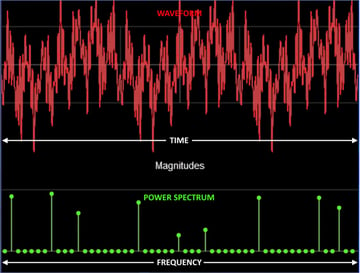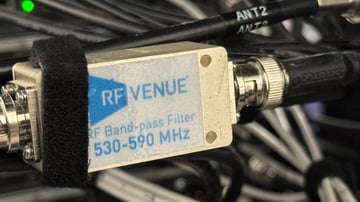- Products
- All Products
- RF PA Extension Kit
- Wireless Microphone Upgrade Packs
- In-Ear Monitor Upgrade Packs
- Wireless Microphone Antennas
- Wireless In-Ear Monitor Antennas
- Antenna Distribution for Microphones
- Antenna Combiners for In-Ear Monitors
- Multi-Zone Antenna Combiners
- Spectrum Tools
- Accessories, Cables and Parts
- Solutions by Venue
- Resources & Training
- Performance Tools
- About Us
When FM broadcasting began, in its earliest form almost 90 years ago, the broadcasters used antennas with horizontal elements, arranged as dipoles —the most basic antenna configuration. It was just the easiest way to build them, especially if they were made into multi-element arrays. Listeners enjoyed the content at home, in their living rooms, on console-type receivers that often were connected to outdoor dipole antennas that also were horizontal.
As FM developed, though the FCC reassigned the service from the 42 – 50 MHz range up to 88 – 108 MHz, broadcasters and listeners stuck to the horizontal antenna idea. The radio signals transmitted thus were horizontally polarized, meaning that the electrical field (one of two components of a radio wave, the other being the magnetic field) was on a horizontal plane. The magnetic field’s orientation is 90 degrees from the electrical field, so in these cases it is vertical.
.png?width=1800&height=600&name=car%20radio%20(1).png)
To receive the radio wave effectively, the receiving antenna needs to be physically somewhat aligned with the electrical field. That allows it to pick up both the electrical and magnetic fields. The antenna will actually pick up reasonably well off-angle up to about 60 or 70 degrees but will start to fall off sharply as it approaches 90 degrees. So when car radios became transistorized and it became feasible to add FM reception, the FM broadcasters had to adapt to the fact that cars almost universally used vertical whip antennas. They turned to using antennas that also produced a vertically polarized signal as well as the horizontal one, with a 90-degree phase difference between them (in other words, in quadrature). This was the beginning of the most widespread use of circular polarization (CP), and it illustrates the main truth of CP: it’s an ideal solution for maintaining a radio link when the orientation of the other antenna is indeterminate.
We face similar challenges with wireless mic and in-ear monitor (IEM) systems. On one end of the link, the location of the antenna or antennas is fixed. The other is portable or wearable and likely to be oriented in any direction. We cannot control how a person holds a handheld wireless mic transmitter or how they wear a body pack transmitter or IEM receiver, so their little external or internal whip antennas — linear polarized, by the way — will tend to be oriented randomly. It makes sense, then, to make the fixed antennas circularly polarized.
In our world, we also need directionality in our fixed antennas to reduce sensitivity to RF noise or to direct IEM signals where they’re needed. RF Venue offers a couple of antennas that fit the need: the CP Beam (a stand-mount unit) and the CP-ARC (a wall- or ceiling-mount architectural unit). The direction of the turns of the spring-like helical element in the CP-Beam imparts a right-hand orientation. The animation in Figure 1 shows a right-hand circular polarized (RHCP — but not the Red Hot Chili Peppers) helical antenna and a partial depiction of the signal it produces. For clarity, the animation shows only the vertical and horizontal angles of the signal and their 90-degree phase relationship, but there is actually signal in all the angles in between, as well. Therefore, the receiving whip antenna of the IEM receiver will always have a good signal to pick up regardless of its position; contrast that with a conventional linear-polarized signal that will not be picked up well if the whip antenna is at or near a right angle to it. This makes the CP Beam and CP-Arc perfect IEM transmitting antennas.

Antenna transmitting and receiving characteristics are exactly reciprocal, so an antenna that is excellent at transmitting to a peripatetic whip antenna will also be excellent at receiving from a similar whip. A circular polarized antenna picks up the signal in any polarization angle with no cross-fade. This makes an antenna like the CP Beam an excellent choice for a spatially diverse antenna pair (two of them, of course).
So in short, a CP antenna is great at transmitting to an IEM receiver’s whip antenna. And a CP antenna is great at receiving from a wireless mic transmitter’s whip antenna!
If you’re curious, you might wonder if a CP antenna can transmit to another CP antenna. The answer is Yes! And No! If they’re both polarized the same way, they’ll work great. But if one is RHCP and the other is LHCP, the reception will be terrible. For the record, RF Venue CP antennas are RHCP.
Bob Lee
Bob Lee is an application engineer and trainer at RF Venue, Inc., having worked in pro audio and broadcasting for more than four decades. Bob started doing live theatre sound in 1980 with analog boards and area mics, because only the biggest theatre companies had wireless back then. He designed and serviced wireless...
More from the blog
Subscribe to email updates
Stay up-to-date on what's happening at this blog and get additional content about the benefits of subscribing.



